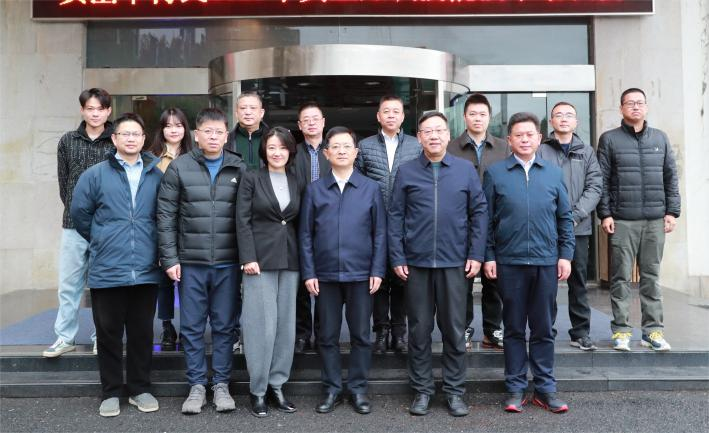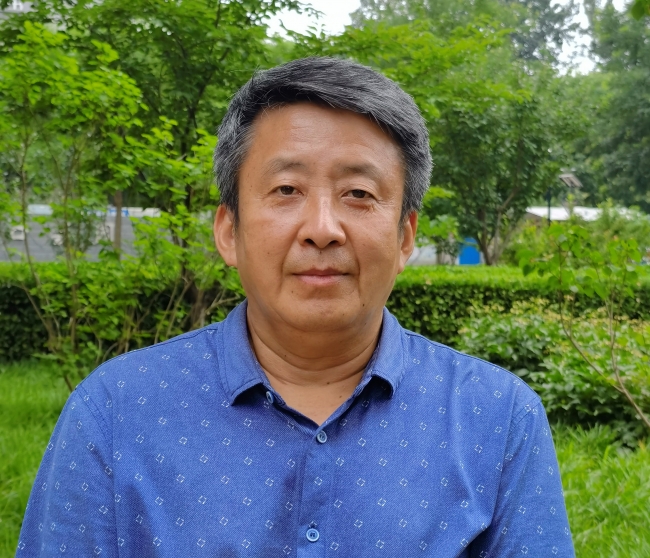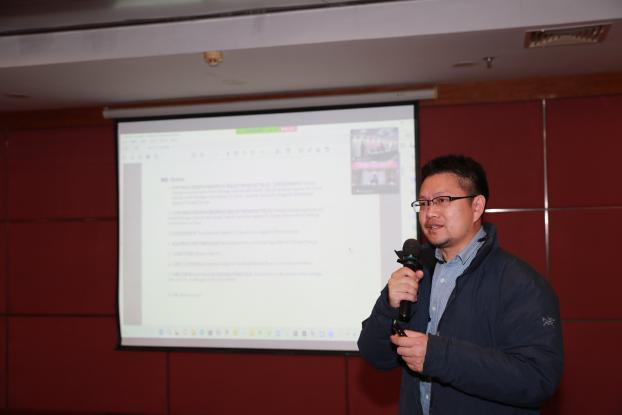| Review | Summary of the Huangshan Pilot Seminar on “Research on International Policy Response to China's Mixed World Heritage Sites under Climate Change Issues” |
| Author:WHITRAP PublishDate:2023-12-18 Hits:1607 |
On December 12, 2023, the Huangshan Pilot Seminar on “Research on International Policy Response to China's Mixed World Heritage Sites under Climate Change Issues” was held in Huangshan, Anhui. This conference was also one of the grand commemorative events for the 33rd anniversary of the inscription of Huangshan on the World Heritage List. The pilot seminar combined both online and offline. It was hosted by the World Heritage Institute of Training and Research for the Asia and the Pacific Region (WHITRAP) and Mount Huangshan Scenic Area Management Committee, undertaken by Shanghai Tongji Urban Planning and Design Institute Co.,Ltd (TJUPDI) and the Planning and Land Department of Mount Huangshan Scenic Area Management Committee.
Photo of the participants
The seminar was hosted by Dr.Mu Xingyu, project director of the WHITRAP. First, she briefed on the background of the conference and then introduced the guests respectively. Afterward, Xu Liqiu, Deputy Secretary of the Party Working Committee and Deputy Director of the Management Committee of Mount Huangshan Scenic Area, delivered a speech at the conference.
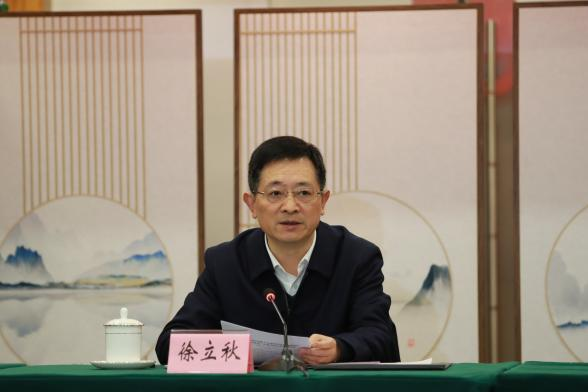 XU Liqiu, Deputy Secretary of the Party Working Committee of Huangshan Scenic Area delivered a speech.
Keynote speech section
Sustainable and Resilient Management of Mixed World Heritage Sites under Climate Change: International Perspectives
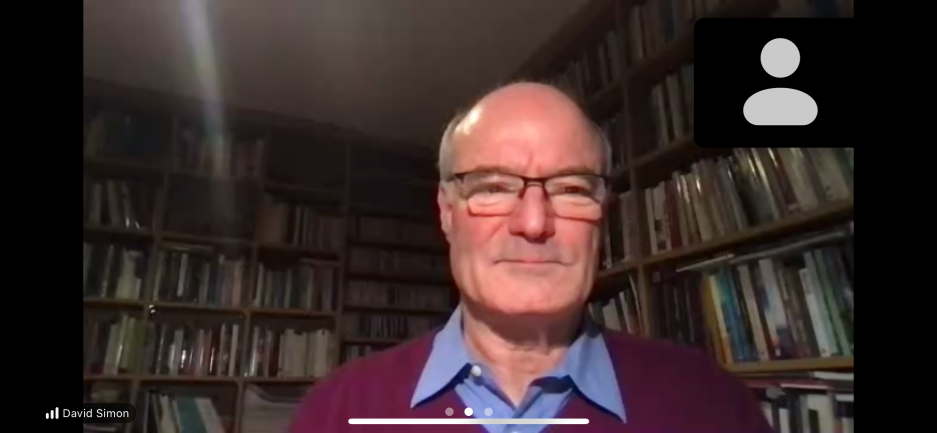 Mr. David Simon, Fellow of the British Academy of Social Sciences gave an online speech. Professor David Simon, Fellow of the British Academy of Social Sciences, delivered an English speech on “Sustainable and Resillient Management of Mixed World Heritage Sites under Climate Change: International Perspectives”. Mr. Simon first pointed out that the UNESCO World Heritage Convention and related guidelines provide a basic principle for heritage on a global scale. Although it is already relatively clear about “what is heritage,” “how to protect heritage,” and “why to protect heritage”, given the context of climate change or environmental change, the answers are dynamic and constantly changing. Mr. Simon further elaborated on four key messages relating to global challenges such as climate change and unsustainability. Finally, Mr. Simon emphasized that methods of dealing with mixed world heritage sites are dynamic, and policies and practices should be adopted to meet future needs; in order to address additional challenges such as climate change and economic inflation, export-oriented policies must be adopted; “the 2030 Agenda for Sustainable Development” provides important opportunities for heritage transformation; and he also pointed out that mixed world heritage sites should be part of a global sustainability and resilience strategy.
Climate Change Risk Assessment and Initial Response Suggestions for Mount Huangshan World Heritage Site
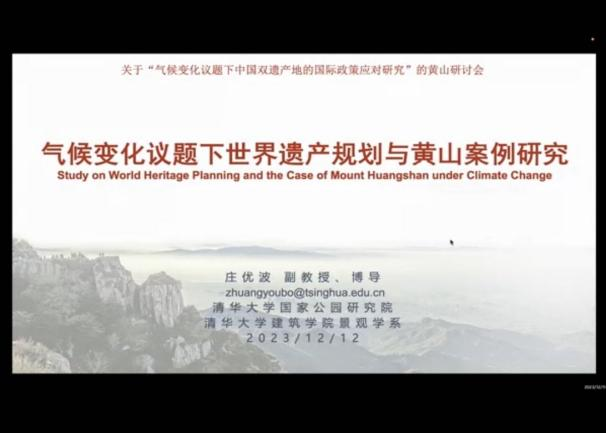 prof. ZHUANG Youbo, Associate Professor from the School of Architecture from Tsinghua University gave an online speech.
Zhuang Youbo, Associate Professor from the School of Architecture, Tsinghua University, delivered a speech on “Climate Change Risk Assessment and Initial Response Suggestions for Mount Huangshan World Heritage Site”. Professor Zhuang introduced the plan for the world heritage from the following four aspects: the impact of climate change on the world heritage site, the UNESCO World Heritage Center's suggestions on world heritage planning against climate change, lessons from other countries in world heritage planning against climate change and China's wisdom for world heritage planning against climate change. Next, Professor Zhuang introduced the study special climate change plan for Mount Huangshan. Finally, Professor Zhuang put forward three suggestions on China's world heritage planning against climate change: 1) on the national level, it is proposed to prepare a special climate action plan for China's World Heritage sites; 2) At the heritage level, heritage site protection management plans should include the responses to climate change; 3) Proposals to safeguard world heritage sites against climate change.
How can World Heritage Sites Respond to the Major Challenges Posed by Global Climate Change
Mr. LI Jianghai, Professor from the School of Earth and Space Sciences, Peking University attended the conference online.
Professor Li Jianghai from the School of Peking University's School of Earth and Space Sciences, Peking University, delivered a speech on “How can World Heritage Sites Respond to the Major Challenges Posed by Global Climate Change”. Professor Li first reviewed the impact of climate change on global world heritage sites, then explained in detail the impact of climate change on China's four mixed world heritage sites and the challenges met by their OUV in terms of authenticity and integrity. Finally, Professor Li pointed out the future direction of China's world heritage sites against global climate change and proposed solutions and countermeasures.
China's Voice on Climate Change Relearning
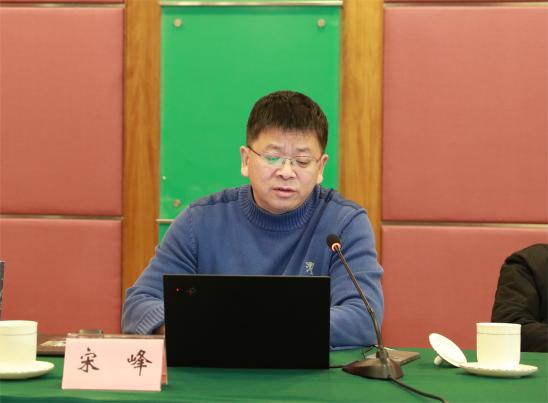 Mr. SONG Feng, Associate Professor from Peking Univeristy's College of Urban and Environmental Sciences
Song Feng, Associate Professor from Peking University’s College of Urban and Environmental Sciences delivered a speech on "China's Voice on Climate Change Relearning". Mr. Song put forward two noteworthy facts:1) Climate change is a large-scale natural phenomenon, and 2) In the field of climate change, China, a developing country, has actually done more than it promised. Afterwards, he shared his understanding after studying President Xi Jinping's article “On Handling Important Relationships in the Enhancement of Ecological Conservation” in the context of world heritage sites and climate change. The construction of ecological civilization should be placed in the context of social development. It is important to take actions based on a systematic and comprehensive recognition, so as to resolutely avoid the one-sided and fragmentated of perceptions and practices.
Responsibility for World Heritage Sites under Climate Change
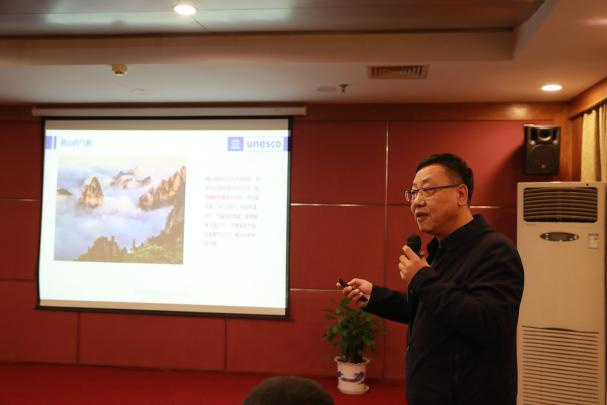 Mr. LIU Baodang, Deputy Secretary General of the World Heritage Expert Committee of National Forestry and Grassland Administration
Mr. Liu Baodang, Deputy Secretary General of the World Heritage Expert Committee of National Forestry and Grassland Administration, delivered a speech on “Responsibility for World Heritage Sites under Climate Change”. Mr. Liu first pointed out that climate change has profoundly affected our present and future. He further focused on the ecological function of China's mixed world heritage and its sheltering function and discussed the responsibility of world heritage sites against climate change from three aspects: first, world heritage sites play the most important role in ecological balance and carbon and oxygen balance, and should become an export base for promoting climate change knowledge for the public; second, the vast majority of the world's mixed heritage in China are mountains and have become shelters for many lives in history. As the climate is warming, cool areas that surround the cultural heritage sites should become distribution centers for city dwellers to escape the heat; third, most of the world heritage sites in China have forests and wetlands, which have important recuperation functions. Cities and communities should build a large-scale rehabilitation base by making good use of cultural heritage sites for curing climate change diseases, helping the city dwellers who have fallen victim to the urban climate change. Finally, Mr. Liu pointed out that now the disasters caused by urban climate change to people are prominent. Heritage sites must take predictive and proactive actions on a strategic level to link communities, surrounding regions, and cities together while planning for the future.
The Biological Shelter in the Context of China's Mixed World Heritage and Climate Change
Dr. WEN Cheng
Dr. Wen Cheng, an expert from the Species Survival Commission of the International Union for Conservation of Nature (IUCN), delivered a speech on “China's Mixed World Heritage and Biological Shelter in the Context of Climate Change”. Mr. Wen used a series of research illustrations to show us the impact and extent of climate change on China's mixed world heritage sites, inspiring everyone to think about the adaptability and sustainable management of heritage sites. In his speech, he explained from three perspectives: first, the spatial relationship between China's future exposure to climate change and China's mixed world heritage property and natural heritage potential zones, and the spatial relationship between China's mixed world heritage property and biological shelters during the Last Glacial Maximum (50,000 to 30,000 years ago) and the Holocene (11,700 years ago); second, the observation of climate change in world heritage sites, including the Hoh Xilin in Qinghai Province and Three Parallel Rivers of Yunnan Protected Areas in Yunnan Province; and third, the ecosystem of the mixed world heritage properties in China and their climatic challenges. The results of the analysis in the above three areas reflect: from 50,000 years ago to about a century from now, Mount Emeishan and Mount Wuyishan are located in regions where the impact of climate change is relatively low; while Mount Huangshan and Mount Taishan are in regions where the impact of climate change is relatively strong. The impact of climate change on the world's natural heritage can be both positive and negative. Active interventions in adaptive management have the potential to eliminate or mitigate the possible negative effects of climate change; interventions require multi-stakeholder participation, particularly in regions where human activity and heritage value elements are interspersed in space, because these regions call for sophisticated planning. In particular, he pointed out that for Mount Huangshan and Mount Taishan, climate change is a background issue that requires special consideration in future management; he is happy to see that scientific considerations in this regard have already been made in the conservation management plan of Mount Huangshan.
Mount Huangshan Practice and Reflection on Coping with Climate Change
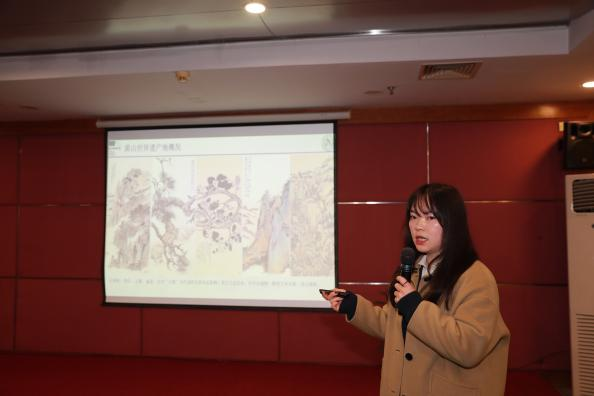 Dr. FANG Yuan introduced the practical work for Mount Huangshan.
Ms. Fang Yuan, Director of Mount Huangshan World Heritage Management Office, delivered a speech on Mount Huangshan Practice and Reflection on Coping with Climate Change”. Ms. Fang first gave an overview of Mount Huangshan World Heritage Site. Ms. Fang further classified Mount Huangshan's practical work to deal with climate change: first, in terms of climate adaptation, the use of manual intervention measures, planning and policy guarantees, and testing, evaluation, and early warning; second, in terms of climate mitigation, the three-part deployment of energy saving and emission reduction work is also being carried out in an orderly manner; third, in terms of capacity building, dealing with climate change through scientific research, experience and knowledge sharing, and regional cooperation. Finally, Director Fang Yuan put forward four thoughts and discussed what else could be done for Mount Huangshan.
Towards a Territorial Approach for Reducing Climate Risks and Building Resilience of Mixed World Heritage Sites
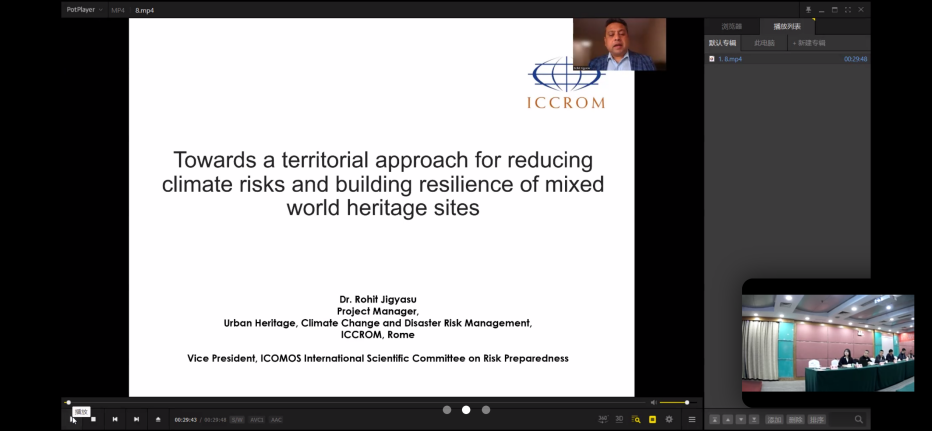 Rohit Jigyasu delivered a wonderful speech online.
ICCROM Urban Heritage, Climate Change and Disaster Risk Management Program Leader Rossi. Mr. Rohit (Jigyasu) gave a speech on "Towards a Territorial Approach for Reducing Climate Risks and Building Resillience of Mixed World Heritage Sites". He first gave a general introduction to the disasters of climate change and the prediction of climate change in the field of international heritage. In the following speech, he detailed the impact of climate change through practical case studies of world heritage and natural heritage sites; and finally presented and explained the preliminary results of the regional approach to climate risk reduction and resilience-building for world heritage sites.
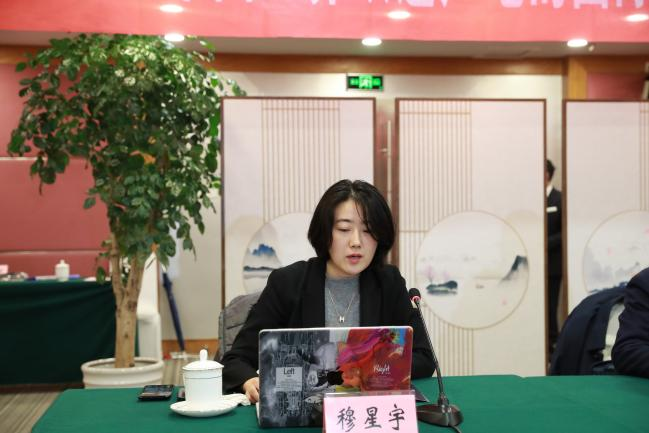 Dr. MU Xingyu gave a summary of the seminar.
After the keynote address, the host Dr. Mu Xingyu gave a summary of the seminar . At this seminar , experts interpreted the response to the mixed world heritage sites from the perspective of their own concerns. One of the two international experts proposed world heritage as a strategic role for resilience in climate change at the global level from the perspective of the “the 2030 Agenda for Sustainable Development”; the other showed everyone international practices and various tools from the perspective of world heritage management and sustainable development. The six domestic experts each gave wonderful speeches on special plans, major challenges, strategic patterns, development directions, the role of “biological shelters”, and Mount Huangshan's experience and practices relating to world heritage sites and climate change. They provided suggestions for “International Policy Response to China's Mixed World Heritage Sites against Climate Change” and provided a good foundation for the deepening of the research.
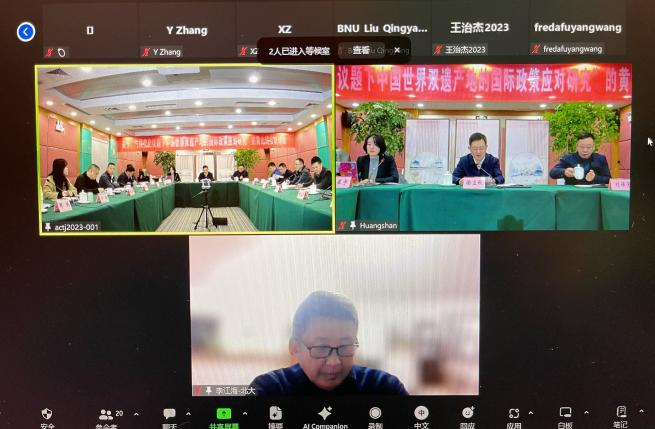 Experts had a lively discussion at the round table.
Afterward, a roundtable discussion was held, presided over by Mr. Liu Baodang. A total of 5 guests attended the roundtable discussion, namely Mr. Song Feng, Mr. Li Jianghai, Mr. Wen Cheng, Mr. Tang Yongjin, and Mr. Xu Liqiu. Mr. Song Feng proposed that guided by the principle of fairness, developed countries should fulfill their commitments and jointly address climate change issues. Mr. Li Jianghai pointed out the need to focus on the World Heritage toolkit and actively use its series of guiding documents to promote the continuous publication of documents. At the same time, attention should also be paid to the work of major research institutions. Mr. Li Jianghai also gave special recognition to the systematic response measures adopted by Mount Huangshan. Afterward, Mr. Wen Cheng also mentioned that as a world heritage Site, Mount Huangshan is a benchmark and model for dealing with climate change issues, and its lessons are worth promoting and learning from. Mr. Tang Yongjin, trade union chairman of the Mount Emeishan Scenic Area Management Committee, shared the Mount Emeishan Scenic Area's exclusive measures to deal with climate change with the present delegates, including building a forest ecosystem, a national positioning observation research station, etc., to test biodiversity. After listening carefully to the opinions and suggestions of all experts, Mr. Xu Liqiu shared his observations by relating to the strategic plans to deal with climate change made by Mount Huangshan. Mr. Xu believed that understanding climate change is not only an academic issue, but also requires combining academic wisdom and management practices to make conservation management work more adaptable. Second, Mount Huangshan's successful selection as a pilot for climate change response is largely attributed to the efforts made by WHITRAP. Thanks very much for the support and the encouragement of WHITRAP. In daily management, Mount Huangshan pays great attention to aspects such as zero- carbon, tourism safety, and balanced management adaptability. Mount Huangshan is also willing to become a model to achieve better protection of heritage sites through applying a more effective mode of management. He called on international organizations and experts to participate in providing guidance to jointly promote the ecological protection of mountain scenic spots. Finally, he sincerely thanked all present experts for sharing their experiences and working together to address the challenges facing world heritage sites.
The seminar reached fruitful outcomes.
Contributed by: MU Xingyu
Translated by: ZHANG Xiaolan
Edited by: DONG Jing (Intern)
|
- News | WHITRAP Shanghai and CNR-ISPC bilateral meeting
- News | WHITRAP meets Cité de l’Architecture et du Patrimoine
- WHITRAP Hosting "Workshop on Preliminary Assessment for National Focal Points of the Asia Region" in Chengdu
- WHITRAP Shanghai meets UNESCO
- INTERNATIONAL CONFERENCE PRELIMINARY ANNOUNCEMENT & CALL FOR PAPERS
- Observation of the 46th Session of the World Heritage Committee
Copyright © 2009-2012 World Heritage Institute of Training and Research-Asia and Pacific (shanghai)


